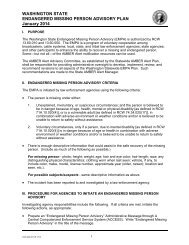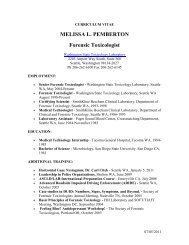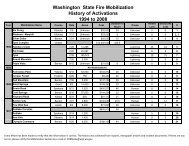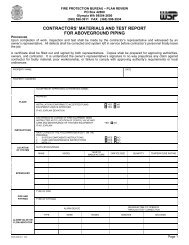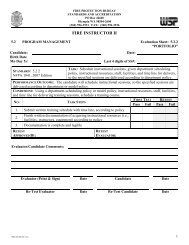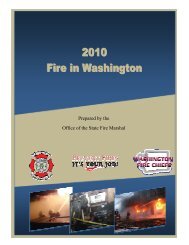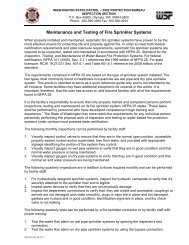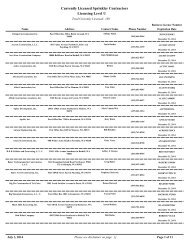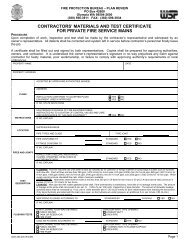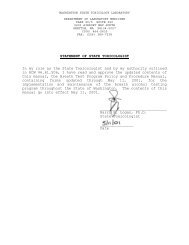Impaired Driving Subcommittee Impaired Driving Guidebook - NHTSA
Impaired Driving Subcommittee Impaired Driving Guidebook - NHTSA
Impaired Driving Subcommittee Impaired Driving Guidebook - NHTSA
You also want an ePaper? Increase the reach of your titles
YUMPU automatically turns print PDFs into web optimized ePapers that Google loves.
LEADERSHIPLAW ENFORCEMENT LEADERSHIPIt is understood that law enforcement cannotsolve the impaired driving problem alone. Clearly,we must work effectively in collaboration with, and insupport of, our partners and stakeholders. This is whyan entire section of this publication is dedicated toPartnerships and Collaborations.However, it is critical that law enforcementleaders prioritize activities aimed at reducingincidents of impaired driving and related crashesthat too often result in fatalities and disabling injuries.As law enforcement leaders at national, state,and local levels, we must deliver a clear andconsistent message of support and encouragementfor strengthened enforcement initiatives.It is acknowledged that most law enforcementagencies are dealing with increased demands, lessstaff, and reduced funding. We must continuallyand effectively motivate our officers throughleadership and clear direction of the need toprioritize traffic law enforcement. Why? In additionto the potential to significantly reduce impaireddriving and related crashes, there is unlimitedpotential for another positive consequence—CRIMEREDUCTION.In the 1990s, many law enforcement agenciesfocused on “the little things” and adapted the“Fixing Broken Windows” strategy to their goals andobjectives 2 . By quickly addressing seeminglyinsignificant crimes, law enforcement deterredpeople from committing larger crimes and drovedown the general crime rate 3 . We should apply thesame strategy to traffic law enforcement. Thejurisdictions that have implemented this strategyhave experienced tremendous success.More citizens formally encounter law enforcementthrough traffic stops than by any other means.The Bureau of Justice Statistics reported in 2002 thatalmost 17 million citizens encounter law enforcementofficers during traffic stops or investigations (thisrepresented approximately 40% of all officer-civiliancontacts! 4 ). By prioritizing traffic law enforcement,we cannot only curtail impaired driving, we willreduce crime overall.Institutionalize your commitment by incorporatingtraffic safety goals into your department’sstrategic plan. In addition to including relevantgoals and objectives, require and track performancemeasures, such as DUI arrests (output measures), insupport of the reduction of traffic fatalities andinjuries (outcome measures).The IACP Highway Safety Committee supportsthe following actions that would assist lawenforcement leaders in renewing our collectiveefforts to significantly reduce impaired driving: Encourage law enforcement member agenciesto revisit their policies and goals regardingimpaired driving. Encourage the State Association of Chiefs ofPolice (SACOP) to endorse, publicize, andaggressively seek participation by their membersin sustained high-visibility impaired drivingenforcement. Institute management and personnel accountabilitysystems specific to crash and enforcementactivity (e.g., TrafficStat, Strategic AdvancementForums 5 ). Ensure that enforcement of impaired driving is anagency priority mission. Provide officers with thetime, training, and tools required to perform thismission as effectively as possible. Create state, regional, and local DUI enforcementtask forces that will produce increasedhigh-visibility enforcement. Increased enforcementshould be directly tied to <strong>NHTSA</strong>’s newNational Crackdown Plan (see Appendix B forthe <strong>NHTSA</strong> Web address). Law enforcement agencies should activelypursue alternate funding sources to support DUIenforcement, training, and equipment. Potentialsources include:⎯⎯⎯⎯⎯⎯Federal, state, and local grantsInsurance companiesLocal civic groupsState-level legislation for dedicated DUI costrecovery funding to arresting agenciesPrivate corporationsNot-for-profit groupsFor additional information on funding, see theIACP’s Highway Safety Deskbook 6 . Encourage the International Association ofDirectors of Law Enforcement Standards andTraining (IADLEST) to continue its endorsement ofthe use of <strong>NHTSA</strong>’s standardized field sobriety testtraining as part of all post-mandated curriculumand to join in a renewed effort to ensure that alllevels of law enforcement training contain a solidemphasis on impaired driving enforcementstrategies, tactics, and techniques.8



